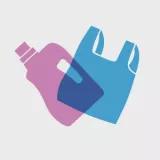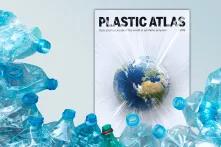Plastic production and use have increased to such an extent in the last 75 years that this material has now come to define its own geological epoch. We are currently living through the Plasticene, with all the advances that these synthetic materials have brought about, but also countless impacts on human health and the environment. Based on current trends, a massive increase in plastic production is expected, even though it is already clear that the planet is awash with plastic litter. In this situation, “business as usual” is not an option.

The vast scale of the plastic crisis is visible everywhere. Plastic is present in our water, in the air we breathe, in the soil, in our food and in most living organisms. It has only been in production for around 75 years, but it has now permeated every corner of our planet, from the Mariana Trench to Mount Everest. In total, an estimated 12 billion tonnes of plastic have been produced since 1950. For comparison, the weight of all living people and animals currently totals around four billion tonnes.
Given the scale of plastic pollution and the global dependence on this material, some people are already calling our era the “Plasticene” – the Age of Plastic. One of the properties which makes plastic so useful in so many areas is also the crux of the problem: plastic has a long lifespan and does not decompose. Instead, it degrades into increasingly tiny fragments, known as micro- and nanoplastics, which are present everywhere: they have even been detected in human placentas and can cross the blood-brain barrier. Greenhouse gas emissions and harmful chemicals are released at every stage of the plastic lifecycle from production to disposal. More than 99% of these synthetic materials are manufactured in chemical processes as derivatives of oil, gas or coal, to which various chemicals, many of them harmful to health, are then added.
Who drives production?
The fossil fuel and petrochemical industries are interlinked and are investing billions in expanding plastic production. With multinational corporations like ExxonMobil, Eni, BASF and Ineos generating billions in profits every year, it is hardly surprising that plastic production is set to increase by as much as 40% in the coming years. Cheap natural gas from fracking drives the massive expansion of the plastic infrastructure in the US and elsewhere. According to some estimates, petrochemicals are set to account for half of the growth in global oil demand by 2050, while plastic production will account for 20% of oil and gas consumption by the same year. This will have dramatic impacts on the climate, for based on this trajectory, emissions from plastic alone will account for 10-13% of the remaining global carbon budget by 2050.
The packaging industry is one of the largest markets for plastic. Packaging accounts for the highest proportion – more than one third – of plastic products worldwide, and most of it is single-use packaging that is only briefly in use before it is thrown into the trash. Retail giants such as Coca-Cola, Nestlé and PepsiCo all source their packaging from manufacturers that are supplied with plastic granulate and petrochemicals from the fossil fuel-based plastics industry. These corporations are driving the massive expansion of plastic production and drowning the planet in oceans of plastic litter.
In 2019, more than 465 million tonnes of plastic were produced worldwide – twice as much as in 2000. Since 2020, the output of single-use products has continued to surge, partly due to the COVID-19 pandemic. Petrochemical industry analysts have identified four COVID-related drivers of demand: (single-use) food packaging, delays in introducing bans on plastic carrier bags, online shopping, and hygiene and medicine. And, of course, surging plastic production leads to even more plastic waste. According to one study, global plastic waste is set to almost triple by 2060. More than eight billion tonnes of plastic waste have been produced globally since 1950. Just 11% of this was recycled and 15% was incinerated, meaning that 74% ended up in the environment or landfill. This is an ongoing trend. Plastic pollution not only impacts our ecosystems’ ability to adapt to climate change; it is also a major driver of biodiversity loss and has detrimental effects on numerous species.
Recycling as the third-best option
Is more recycling the solution? In 2019, according to the OECD, just 9% of plastic was recycled globally. Recycling plastic is not a straightforward process. Many types of plastic packaging consist of composites that are impossible to separate and therefore cannot be recycled. The sheer variety of synthetic materials in use also poses a challenge: there are so many different dyes, additives and compounds that they cannot easily be combined. And who wants a yoghurt pot made from recycled material that previously contained toxic flame retardants, for example? These are some of the issues that arise in mechanical recycling, in which the materials are melted down for reuse after being sorted. The plastic industry is currently extolling the virtues of chemical recycling as a further option, in the hope that highly diverse and contaminated plastics will then be suitable for reuse as well. In chemical processes such as pyrolysis or gasification, the plastics are broken down into chemical substances (monomers or oligomers) which can then be used again to produce polymers, i.e. plastic. Although this sounds like a promising approach to avoid the production of new primary plastics, the process has come in for considerable criticism, for various reasons: it consumes large amounts of energy, it releases harmful substances into the environment, and it produces toxic residues that have to be treated. In addition, the technology is not well-advanced or marketable on a large scale. In short, conventional mechanical recycling – for all its shortcomings, mentioned above – is still the better option for most plastic waste.
In any case, recycling is only the third preferred option for packaging, after avoidance and multi-use solutions, although the retail trade takes a different view. Last year, food discounter Lidl was keen to demonstrate its environmental credentials by launching a bottle made from 100% recycled material. Perhaps we should be grateful to Lidl for prompting an influx of corrections and clarifications: it is not possible to have a closed loop for plastic (or other material) without some losses, and 100% recycling simply means that PET is bought in and fed into the production process – PET that is produced from raw materials elsewhere.
Pollutants affect everyone – but vulnerable groups more frequently and severely
We come into contact with the harmful substances of which plastic is made – intentionally or not – whenever we use plastic products. “Forever chemicals” which do not break down in the environment, such as per- and polyfluoroalkyl substances (PFAS), are found in cosmetics, cookware, paper coatings, textiles and other everyday items. From here, they enter our soil and accumulate in the human body, potentially causing serious illness. Some plastics also contain hormone-disrupting chemicals. This is not good news, especially for women and girls, whose bodies react with particular sensitivity to these substances.
In fact, plastic affects the sexes in different ways, with social inequality and defined gender roles playing an important role. In addition, the low-wage sector and – generally poor – communities living near petrochemical plants, landfill sites or incinerators are often highly exposed to toxics and pollutants and this frequently has serious health effects in these communities. People who earn a living by collecting and sorting plastic waste are especially exposed to these risks. The United Nations Environment Programme (UNEP) warns that the environmental, social, economic and health risks of plastic are now just as severe and onerous as the impacts of the climate crisis, ecosystem loss and natural resource depletion.
Ways out of the plastic crisis
Plastic production and use must therefore be reduced as a matter of urgency – while according to forecasts, plastic consumption is set to triple by 2060. However, a multitude of solutions already exist. With smart design, it is possible to greatly extend the lifespan of many of these products and make packaging far less resource-intensive. Single-use packaging for cosmetics and food, for example, can and must be replaced by multi-use systems. If these systems are harmonised so that packaging can be handed back anywhere – like the system for soda and beer bottles that we are familiar with in Germany – consumers will make use of them. And many goods could be sold without packaging. These solutions will not work without government regulation, however, which is why major hopes are now resting on the United Nations resolution on a global agreement on plastic pollution. The negotiations are still under way, but if a legally binding global agreement is successfully concluded – one which takes the start of the plastic production chain as its entry point, regulates the chemicals involved and consults with particularly vulnerable groups – the world could move a step closer to a solution.



